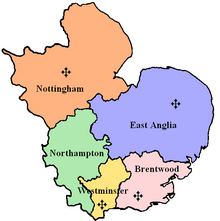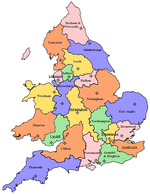Roman Catholic Diocese of East Anglia
Diocese of East Anglia Dioecesis Angliae Orientalis | |
|---|---|
 Arms of the Roman Catholic Diocese of East Anglia | |
| Location | |
| Country | England |
| Territory | Counties of Norfolk, Suffolk, Cambridgeshire, and the Unitary Authority of Peterborough |
| Ecclesiastical province | Westminster |
| Metropolitan | Westminster |
| Deaneries | Bury St Edmunds, Cambridge, Great Yarmouth, Ipswich, King's Lynn, Norwich, Peterborough |
| Coordinates | 52°24′11″N 0°54′11″E / 52.403°N 0.903°ECoordinates: 52°24′11″N 0°54′11″E / 52.403°N 0.903°E |
| Statistics | |
| Area | 12,570 km2 (4,850 sq mi) |
| Population - Total - Catholics (including non-members) | (as of 2019) 2,487,200 108,000[2] (4.3%) |
| Parishes | 50 |
| Schools | 28[1] |
| Information | |
| Denomination | Roman Catholic (RC) |
| Rite | Latin Rite |
| Established | 13 March 1976 |
| Cathedral | St John the Baptist Cathedral, Norwich |
| Patron saints | Our Lady of Walsingham, St. Felix, St. Etheldreda, St. Edmund |
| Secular priests | 96 |
| Current leadership | |
| Pope | Francis |
| Bishop | Alan Hopes |
| Metropolitan Archbishop | Vincent Nichols |
| Vicar General | |
| Map | |
 Roman Catholic Diocese of East Anglia, within the Province of Westminster | |
| Website | |
| RCDEA.org.uk | |
The Roman Catholic Diocese of East Anglia is a diocese of the Latin Church of the Roman Catholic Church covering the counties of Cambridgeshire, Norfolk, Suffolk, and Peterborough in eastern England. The diocese makes up part of the Catholic Association Pilgrimage.
Statistics[]
There are 85,309 members of the church, who belong to the 50 parishes in the diocese. The patrons of the diocese are Our Lady of Walsingham (24 September), St Felix (8 March), and St Edmund (20 November).
Churches[]
The diocese is divided into seven deaneries, which are in turn divided into 50 parishes. Note that the list below is not exhaustive, and includes only notable parishes.
Deanery of Bury St Edmunds (St Edmund)[]
| parish name | church | location | web | founded | building |
|---|---|---|---|---|---|
| St Edmund | St Edmund King & Martyr, Bury St Edmunds | Bury St Edmunds, Suffolk | [1] | 1763 | 1837 |
Masses are also said at RAF Lakenheath, at Clare Priory, at the Monastery of Our Lady of Mount Carmel in Quidenham, at the care home of the Sisters of Our Lady of Grace and Compassion in Great Barton, and in the villages of Cavendish and Woolpit.[3]
Deanery of Cambridge (St Andrew)[]
| parish name | church | location | web | founded | building |
|---|---|---|---|---|---|
| Our Lady & the English Martyrs | Our Lady of the Assumption & the English Martyrs, Cambridge | Cambridge, Cambridgeshire | [2] | c. 1841 | 1890 |
| St Laurence | St Laurence, Cambridge | Cambridge, Cambridgeshire | [3] | early C20th | 1958 |
| St Etheldreda | St Etheldreda, Ely | Ely, Cambridgeshire | [4] | c. 1890 | 1903 |
| Sacred Heart | Sacred Heart, St Ives | St Ives, Cambridgeshire | [5] | late C19th | 1902 |
Masses are also said at RAF Alconbury, at Blackfriars, the Dominican Priory of St Michael, Cambridge, at Fisher House University Chaplaincy, and in the villages of Bar Hill and Papworth Everard.[3]
Deanery of Great Yarmouth (St Peter)[]
| parish name | church | location | web | founded | building |
|---|---|---|---|---|---|
| Great Yarmouth | St Mary, Great Yarmouth | Great Yarmouth, Norfolk | [6] | 1824 | 1850 |
1No longer listed on diocesan website.
Deanery of Ipswich (St Edward)[]
- Aldeburgh with Leiston Parish[4]
- St James, Ipswich
- St Mark's Parish[5]
- St Mary's Parish[6]
- St Mary, Ipswich
- St Mary Magdalen, Ipswich[7]
- St Pancras, Ipswich[8]
- Woodbridge and Framlingham Parish[9][10]
Deanery of King's Lynn (St Wilfrid)[]
- St Dominic, Downham Market[11]
- Basilica of Our Lady of Walsingham[12]
- Our Lady & St Charles Borromeo, Wisbech[13]
Deanery of Norwich (St Felix)[]
Deanery of Peterborough (St Hugh)[]
- St Peter & All Souls, Peterborough[15]
History[]
[16]Formed in March 1976 by a papal decree, the Diocese of East Anglia comprises the counties of Norfolk, Suffolk and Cambridgeshire and the city of Peterborough.
On March 13, 1976, by decree Quod Ecumenicum, Pope Paul VI formed the Diocese of East Anglia out of the Diocese of Northampton.
On June 2, 1976, the new diocese received its first bishop, Alan Clark. Bishop Alan had previously been Auxiliary Bishop of Northampton and co-chairman of ARCIC (Anglican/Roman Catholic International Commission). Being the first bishop of the new diocese, Bishop Alan had to set up all the necessary instruments and commissions for the diocese to operate successfully. The establishment of the Diocesan Pastoral Council in 1987 strengthened these.
The diocese continued to grow with the development of the Diocesan offices and Diocesan Tribunal attached to Bishop’s House in Poringland near Norwich. Bishop Alan led a number of Lourdes Pilgrimages.
Following his 75th birthday in August 1994 Bishop Alan retired as Bishop of East Anglia.
On March 21, 1995, Peter Smith, Rector of St John’s Seminary, Southwark Archdiocese, was appointed the second Bishop of East Anglia by Pope John-Paul II. He was ordained Bishop in St John’s Cathedral in Norwich on Saturday May 27, 1995, by the late Cardinal Basil Hume.
On Friday February 14, 2003, Pope John Paul II appointed Canon Michael Evans as the third Bishop of East Anglia. He succeeded the Most Rev Peter Smith, who became the Archbishop of Cardiff (and later the Archbishop of Southwark).
Canon Michael was ordained as the third bishop of East Anglia at St John’s Cathedral on Wednesday March 19, 2003.
Sadly, Bishop Michael Evans passed away after a very brave fight against cancer on July 11, 2011 whilst still in office.
Following Bishop Michael’s death, Vicar General Fr David Bagstaff acted as Diocesan Administrator during the inter-regnum.
On June 11, 2013, Pope Francis appointed Bishop Alan Hopes as the fourth Bishop of East Anglia and he was duly installed on July 16, 2013 at St John’s Cathedral, by Cardinal Vincent Nichols, Archbishop of Westminster, in front of a congregation of nearly 2,000 people.
In November 2014, Bishop Alan was made a Knight Commander with Star of The Equestrian Order of The Holy Sepulchre of Jerusalem.
A Cathedral Chapter was established with the installation of nine Canons at a Solemn Mass at St John the Baptist on March 17, 2016. The Canons also act as a College of Consultors for the bishop.
On June 3, 2016, the Diocese of East Anglia celebrated its 40th Anniversary with a Mass at St John’s Cathedral. The preacher was Cardinal Nichols.
The Apostolic Nuncio to Great Britain, His Excellency Archbishop Edward Adams, conducted a four-day visit to the Diocese of East Anglia in May 2019.
Ordinaries[]
- Alan Charles Clark (appointed on 26 April 1976 – retired on 21 March 1995)
- Peter David Smith (appointed on 21 March 1995 – translated to the Archdiocese of Cardiff on 26 October 2001)
- Michael Charles Evans (appointed on 14 February 2003 – died in office on 11 July 2011)
- Alan Hopes (appointed on 11 June 2013)
Pilgrimage[]
The diocese makes up part of the Catholic Association Pilgrimage.
References[]
- ^ "Find a School". www.RCDEA.org.uk. Roman Catholic Diocese of East Anglia. Retrieved 18 March 2021.
- ^ "Catholic Hierarchy: Diocese of East Anglia". www.Catholic-Hierarchy.org. Retrieved 22 July 2020.
- ^ Jump up to: a b "Churches". www.RCDEA.org.uk. Roman Catholic Diocese of East Anglia.
- ^ aldeburghwithleistonrc. "Home – aldeburghwithleistonrc". aldeburghwithleistonrc.co.uk. Retrieved 25 November 2017.
- ^ Ipswich, St Mark's Catholic Parish. "St Mark's Catholic Parish". stmarksparish.org.uk. Retrieved 25 November 2017.
- ^ "st-mary.org.uk – Welcome to St Mary's Catholic Parish". st-mary.org.uk. Retrieved 25 November 2017.
- ^ Magdalen, St. Mary. "Home | St. Mary Magdalen | Roman Catholic Church, Ipswich, Suffolk, UK". marymagdalens.org. Retrieved 25 November 2017.
- ^ Ltd., Glaccum Consulting. "St Pancras Catholic Church". stpancraschurch.org.uk. Retrieved 25 November 2017.
- ^ "Parish of Woodbridge and Framlingham". wfrcp.org.uk. Retrieved 25 November 2017.
- ^ "Calendar of Events". stthomas-woodbridge.co.uk. Retrieved 25 November 2017.
- ^ "St. Dominic's Catholic Church, Downham Market". stdomsdownham.blogspot.co.uk. Retrieved 25 November 2017.
- ^ "Walsingham | National Shrine of Our Lady at Walsingham". www.walsingham.org.uk. Retrieved 25 November 2017.
- ^ "Our Lady & St Charles Borromeo Roman Catholic Parish Church". catholic-wisbech.uk. Retrieved 25 November 2017.
- ^ "Home". The Cathedral of St John the Baptist. Retrieved 25 November 2017.
- ^ "www.stpeterandallsouls.org.uk – Welcome". stpeterandallsouls.org.uk. Retrieved 25 November 2017.
- ^ "History of the Diocese".
External links[]
- Roman Catholic diocese of East Anglia — official website
- Roman Catholic Diocese of East Anglia
- Religion in Suffolk
- Religion in Norfolk
- Christianity in Cambridgeshire
- Christian organizations established in 1976
- Roman Catholic dioceses and prelatures established in the 20th century
- 1976 establishments in England
- Roman Catholic Ecclesiastical Province of Westminster


